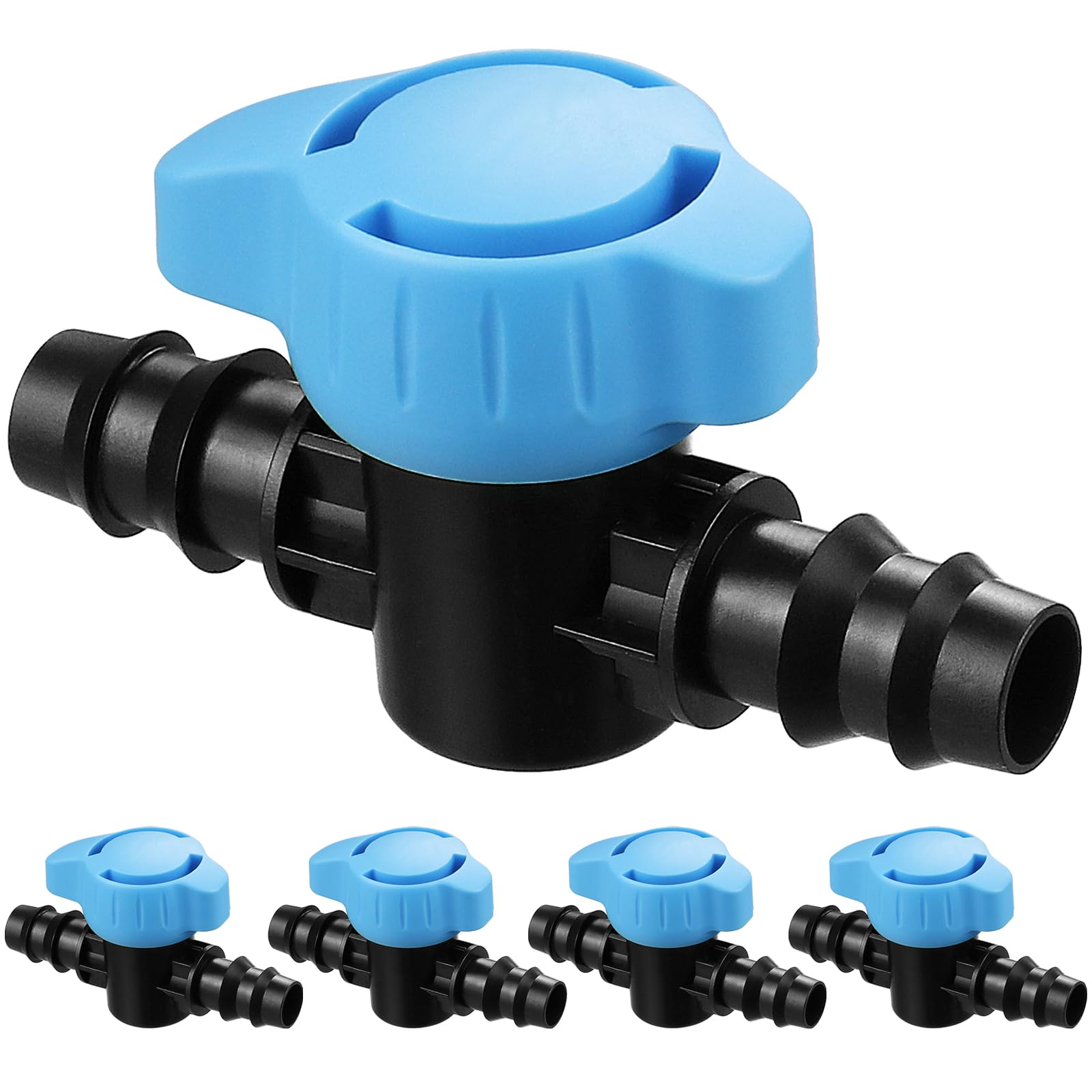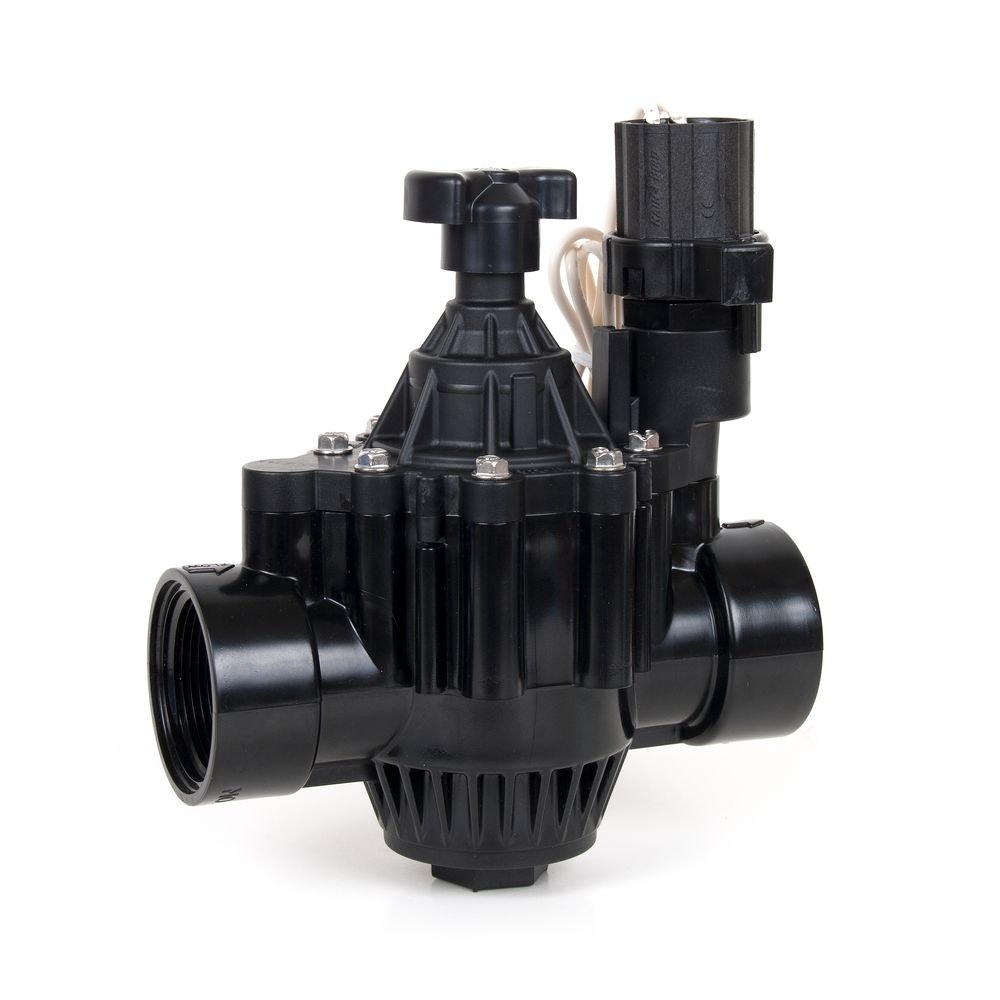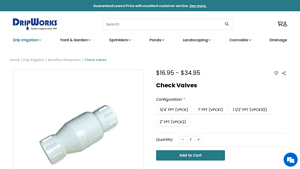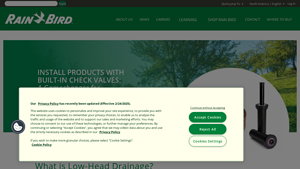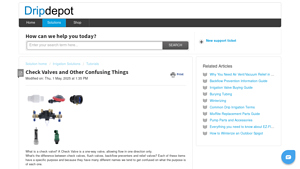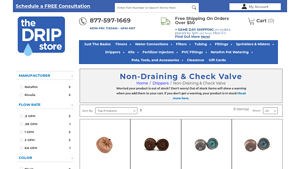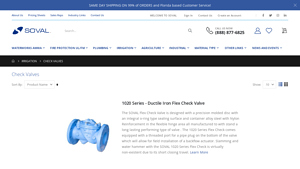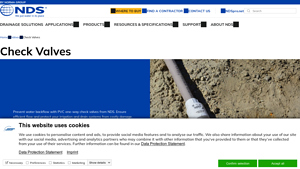Introduction: Navigating the Global Market for irrigation one way valve
In the ever-evolving landscape of global agriculture, sourcing reliable irrigation one-way valves poses a significant challenge for international B2B buyers. As water scarcity becomes a pressing issue across regions like Africa, South America, the Middle East, and Europe, the importance of efficient water management systems cannot be overstated. One-way valves play a crucial role in preventing backflow and maintaining optimal pressure within irrigation systems, ultimately ensuring that water is used effectively and sustainably.
This comprehensive guide delves into the various types of irrigation one-way valves available in the market, highlighting their applications in diverse agricultural and landscaping contexts. From foot valves to flanged check valves, we will explore how each type functions and the specific scenarios in which they excel. Additionally, the guide will provide actionable insights into supplier vetting processes, cost considerations, and the latest technological advancements in valve design.
By equipping international buyers with the knowledge needed to make informed purchasing decisions, this guide empowers businesses to enhance their irrigation systems while mitigating waste and maximizing productivity. Whether you’re operating in the bustling agricultural sectors of Vietnam or the arid landscapes of Saudi Arabia, understanding the nuances of irrigation one-way valves is key to optimizing your water management strategies and achieving sustainable growth.
Understanding irrigation one way valve Types and Variations
| Type Name | Key Distinguishing Features | Primary B2B Applications | Brief Pros & Cons for Buyers |
|---|---|---|---|
| Sprinkler Check Valve | Automatically shuts off when pressure drops; prevents low-head drainage | Landscape irrigation, residential systems | Pros: Reduces water waste, easy installation. Cons: May require regular maintenance. |
| Foot Valve | Installed at the base of a pump; retains water in the system | Well and pond pumping systems | Pros: Keeps the pump primed, prevents backflow. Cons: Can be affected by sediment buildup. |
| Flanged Check Valve | Features flanged ends for secure connections; durable construction | Industrial irrigation systems, pumping stations | Pros: Robust design, easy to install and maintain. Cons: Higher initial cost compared to other types. |
| Inline Check Valve | Compact design; installed within piping systems | Drip irrigation, commercial agriculture | Pros: Space-saving, effective in preventing backflow. Cons: Limited to specific pipe sizes. |
| Built-in Check Valve | Integrated into irrigation components; prevents low-head drainage | Sustainable irrigation products | Pros: Reduces installation complexity, conserves water. Cons: Replacement can be more challenging. |
What Are the Key Characteristics of Sprinkler Check Valves?
Sprinkler check valves are essential for maintaining optimal water flow in irrigation systems. They automatically close when pressure drops, preventing backflow and low-head drainage. This feature is particularly beneficial in landscape irrigation and residential systems, where water conservation is critical. Buyers should consider the ease of installation and the need for occasional maintenance to ensure long-term functionality.
How Do Foot Valves Function in Irrigation Systems?
Foot valves serve a crucial role in pumping systems by allowing water to flow into the pipe while preventing backflow when the pump is off. Typically installed at the base of wells or ponds, these valves are vital for maintaining pump priming. B2B buyers should evaluate the durability of materials, as sediment buildup can affect performance and necessitate regular cleaning.
What Benefits Do Flanged Check Valves Offer?
Flanged check valves are designed for robust applications, featuring flanged connections that ensure secure attachment to pipes and pumps. Their durability makes them suitable for industrial irrigation systems and pumping stations, where maintaining water pressure is critical. While they offer easy installation and maintenance, buyers should be prepared for a higher initial investment compared to other valve types.
Why Choose Inline Check Valves for Space Constraints?
Inline check valves are compact and designed to fit directly into existing piping systems, making them ideal for drip irrigation and commercial agricultural applications. Their ability to prevent backflow without taking up additional space is a significant advantage. However, B2B buyers must consider compatibility with pipe sizes and the potential for limited flow rates.
How Do Built-in Check Valves Enhance Sustainable Irrigation?
Built-in check valves are integrated into irrigation components, simplifying installation and contributing to sustainable practices by preventing low-head drainage. These valves help conserve water and reduce overall system complexity. However, buyers should be aware that replacing these integrated components can be more complex, requiring careful planning and consideration during the purchasing process.
Key Industrial Applications of irrigation one way valve
| Industry/Sector | Specific Application of Irrigation One Way Valve | Value/Benefit for the Business | Key Sourcing Considerations for this Application |
|---|---|---|---|
| Agriculture | Preventing backflow in irrigation systems for crop watering | Ensures optimal water usage, prevents contamination, and protects pumps | Material durability, pressure ratings, and compliance with local regulations |
| Landscape Architecture | Managing drainage in landscaped areas with elevation changes | Reduces water wastage, minimizes erosion, and maintains aesthetic appeal | Design compatibility, size specifications, and ease of installation |
| Municipal Water Management | Controlling water flow in public irrigation systems | Enhances system efficiency, protects infrastructure from damage | Availability of bulk purchasing options and adherence to safety standards |
| Golf Course Management | Maintaining consistent water pressure across varying terrains | Improves course maintenance, enhances playability, and conserves water | Customization options and longevity under diverse environmental conditions |
| Industrial Facilities | Regulating water flow in cooling systems and industrial processes | Prevents equipment damage, ensures system reliability, and reduces operational costs | Technical support and service agreements for maintenance and repairs |
How is the Irrigation One Way Valve Used in Agriculture?
In agriculture, irrigation one way valves are essential for preventing backflow in irrigation systems. They ensure that water flows efficiently to crops while preventing contamination from stagnant water. This is particularly important in regions with variable pressure, such as those in Africa and South America, where maintaining consistent water quality is crucial for crop yield. Buyers should consider the material durability of these valves, as well as their pressure ratings, to ensure compatibility with their specific irrigation systems and compliance with local agricultural regulations.
What Role Do Irrigation One Way Valves Play in Landscape Architecture?
In landscape architecture, these valves are used to manage drainage effectively, especially in areas with significant elevation changes. By preventing water from flowing back downhill, they help to conserve water and minimize soil erosion, which can damage plants and landscaping features. This application is vital in regions like the Middle East, where water scarcity is a concern. Buyers should focus on design compatibility and size specifications to ensure seamless integration into existing landscape systems.
How Do Municipal Water Management Systems Benefit from Irrigation One Way Valves?
Municipal water management systems utilize irrigation one way valves to control the flow of water in public parks and green spaces. These valves enhance system efficiency by preventing backflow, which can lead to infrastructure damage and water quality issues. For international buyers, especially in Europe, sourcing these valves in bulk and ensuring they meet safety standards is crucial to maintaining reliable public services and safeguarding community health.
What Advantages Do Golf Courses Gain from Using Irrigation One Way Valves?
Golf courses benefit significantly from the use of irrigation one way valves, which help maintain consistent water pressure across various terrains. This ensures that all areas of the course receive adequate water without causing oversaturation in low-lying regions. In countries like Saudi Arabia, where golf courses often feature intricate designs and landscaping, the ability to conserve water while maintaining playability is essential. Buyers should seek customization options to meet the unique demands of their courses while ensuring longevity under diverse environmental conditions.
Why Are Irrigation One Way Valves Important for Industrial Facilities?
In industrial facilities, irrigation one way valves play a critical role in regulating water flow within cooling systems and various processes. They prevent backflow, which can damage sensitive equipment and lead to costly downtime. This is particularly important in regions with fluctuating pressure and temperature. Buyers should prioritize technical support and service agreements when sourcing these valves to ensure reliable operation and maintenance over time, ultimately reducing operational costs and improving system efficiency.
3 Common User Pain Points for ‘irrigation one way valve’ & Their Solutions
Scenario 1: Water Waste and Erosion Issues in Sloped Landscapes
The Problem: Many B2B buyers, particularly those involved in agricultural or landscaping projects, face significant challenges with water waste and erosion in sloped terrains. When irrigation systems shut off, gravity causes water to flow back down the slope, leading to excessive watering at lower points. This not only wastes water but can also create puddles that lead to soil erosion and damage to the landscape. Such issues can result in increased maintenance costs and reduced crop yield or landscape quality, impacting overall project profitability.
The Solution: To address this issue, sourcing and installing high-quality one-way check valves is essential. These valves can be strategically placed at low points in the irrigation system to prevent backflow when the system is off. When selecting a valve, consider models with built-in features that cater to elevation changes and are designed to withstand the specific environmental conditions of your project. Conduct thorough research on suppliers who offer durable options, such as those made from corrosion-resistant materials. Additionally, ensure proper installation by collaborating with skilled technicians who can assess the system’s layout. Regular maintenance checks will also help to ensure that the valves remain functional, thereby conserving water and protecting the landscape.
Scenario 2: Backflow Contamination Risks
The Problem: Businesses that rely on irrigation systems are often concerned about the risk of backflow, which can lead to contamination of the main water supply. This is particularly critical for agricultural enterprises that use fertilizers or chemicals in their irrigation processes. Without proper prevention measures, harmful substances can inadvertently flow back into the water supply, posing health risks and potentially leading to regulatory penalties.
The Solution: To mitigate backflow risks, it is crucial to install one-way check valves in conjunction with dedicated backflow prevention devices. While check valves prevent water from flowing backward within the irrigation system, they do not provide complete protection against contamination. Therefore, integrating a backflow preventer specifically designed for your irrigation setup is vital. When sourcing these components, ensure they meet local building codes and industry standards. Additionally, consider partnering with suppliers who offer comprehensive solutions, including installation services and ongoing support for maintenance. Regular testing and inspection of both check valves and backflow preventers will enhance the safety and reliability of your irrigation system.
Scenario 3: Inefficient System Pressure Management
The Problem: B2B buyers often encounter challenges related to fluctuating water pressure within their irrigation systems, particularly when pumps are involved. Pressure changes can lead to inefficient watering, damaging equipment and resulting in uneven moisture distribution across the landscape. This can negatively affect crop health and increase operational costs due to equipment wear and tear.
The Solution: Implementing one-way check valves can significantly improve pressure management in irrigation systems. These valves ensure that water flows in a single direction, maintaining consistent pressure levels and preventing backflow that can disrupt system performance. When selecting check valves, prioritize models with internal mechanisms designed to handle high-pressure conditions. It is also advisable to conduct a thorough analysis of your irrigation system to identify critical points where pressure fluctuations are most prominent. Collaborating with experienced irrigation consultants can help in tailoring a solution that includes the optimal placement of check valves and other pressure-regulating devices. Regular monitoring and adjustments based on seasonal changes will further enhance system efficiency, leading to cost savings and improved irrigation outcomes.
Strategic Material Selection Guide for irrigation one way valve
When selecting materials for irrigation one-way valves, it’s essential to consider the specific properties and performance requirements that will meet the diverse needs of international B2B buyers. The choice of material impacts not only the durability and functionality of the valves but also their compliance with local standards and environmental conditions. Here, we analyze four common materials used in the manufacturing of irrigation one-way valves: brass, stainless steel, PVC, and cast iron.
What Are the Key Properties of Brass for Irrigation One-Way Valves?
Brass is a popular choice for irrigation one-way valves due to its excellent corrosion resistance and mechanical properties. It can withstand high pressures and temperatures, making it suitable for various irrigation applications. Brass valves typically have a pressure rating of up to 200 PSI and can function effectively in temperature ranges from -20°F to 180°F.
Pros: Brass is durable, easy to machine, and has a long lifespan. Its resistance to corrosion makes it ideal for environments with moisture and chemicals.
Cons: The cost of brass can be relatively high compared to other materials, which may deter budget-conscious buyers. Additionally, brass is susceptible to dezincification, which can weaken the material over time if not properly treated.
Impact on Application: Brass valves are compatible with potable water, making them suitable for agricultural and residential irrigation systems.
Considerations for International Buyers: Buyers in regions like Europe and the Middle East should ensure compliance with local standards such as EN and ASTM for drinking water applications.
How Does Stainless Steel Compare for One-Way Valves in Irrigation?
Stainless steel is another robust option for irrigation one-way valves, known for its exceptional strength and corrosion resistance. It can handle pressures of up to 300 PSI and operates effectively in temperatures ranging from -50°F to 400°F, making it suitable for extreme environments.
Pros: Stainless steel is highly durable and resistant to rust, making it ideal for harsh climates. Its aesthetic appeal also makes it a preferred choice for visible installations.
Cons: The manufacturing complexity of stainless steel can lead to higher production costs. Additionally, stainless steel valves can be heavier, which may complicate installation.
Impact on Application: These valves are suitable for both agricultural and industrial applications, particularly where high pressures are involved.
Considerations for International Buyers: Compliance with standards like ISO and JIS is crucial for buyers in Asia and South America, where specific regulations may govern the use of stainless steel in irrigation systems.
What Are the Benefits of PVC in Irrigation One-Way Valves?
PVC is widely used in irrigation systems due to its lightweight nature and resistance to corrosion. PVC valves typically have a pressure rating of up to 150 PSI and can operate in temperatures ranging from 32°F to 140°F.
Pros: PVC is cost-effective, easy to install, and resistant to a variety of chemicals, making it suitable for agricultural applications.
Cons: While PVC is durable, it is less robust than metals and can become brittle over time when exposed to UV light.
Impact on Application: PVC valves are ideal for low-pressure irrigation systems and are commonly used in drip irrigation setups.
Considerations for International Buyers: Buyers should verify compliance with local regulations, such as ASTM D2466, particularly in regions like Africa where standards may vary.
Why Choose Cast Iron for Irrigation One-Way Valves?
Cast iron is known for its strength and durability, making it a good choice for heavy-duty irrigation applications. It can withstand high pressures, typically rated up to 250 PSI, and operates effectively in various temperature ranges.
Pros: Cast iron valves are extremely durable and can handle significant wear and tear. They are also resistant to high temperatures and pressures.
Cons: The weight of cast iron can complicate installation and transportation. Additionally, it is prone to corrosion if not properly coated.
Impact on Application: These valves are best suited for industrial irrigation systems where high durability is required.
Considerations for International Buyers: Buyers should be aware of compliance with local standards such as DIN and ANSI, especially in Europe and the Middle East.
Summary Table of Material Selection for Irrigation One-Way Valves
| Material | Typical Use Case for irrigation one way valve | Key Advantage | Key Disadvantage/Limitation | Relative Cost (Low/Med/High) |
|---|---|---|---|---|
| Brass | Residential and agricultural irrigation | Excellent corrosion resistance | Higher cost, susceptible to dezincification | High |
| Stainless Steel | Industrial and agricultural applications | Exceptional strength and durability | Higher manufacturing complexity | High |
| PVC | Low-pressure irrigation systems | Cost-effective and lightweight | Less durable, can become brittle | Low |
| Cast Iron | Heavy-duty industrial irrigation systems | Extremely durable and high pressure rating | Heavy, prone to corrosion if uncoated | Medium |
This strategic material selection guide provides valuable insights for B2B buyers, helping them make informed decisions based on their specific irrigation needs and regional compliance requirements.
In-depth Look: Manufacturing Processes and Quality Assurance for irrigation one way valve
What Are the Key Stages in the Manufacturing Process of Irrigation One-Way Valves?
The manufacturing of irrigation one-way valves involves several critical stages, each contributing to the overall quality and performance of the final product. Understanding these processes can empower B2B buyers to make informed decisions about their suppliers.
Material Preparation
The first step in manufacturing involves sourcing and preparing raw materials. Common materials for irrigation valves include brass, stainless steel, and durable plastics. These materials are selected for their resistance to corrosion and wear, which is essential in agricultural environments. Quality control begins at this stage, where incoming materials undergo inspections to verify compliance with specifications.Forming
The forming process typically includes techniques such as casting, machining, and molding. In casting, molten metal is poured into molds to create the valve body. Precision machining is then employed to shape and finish components, ensuring that they meet exact dimensions and tolerances. For plastic valves, injection molding is often used, where heated plastic is injected into molds. This stage requires rigorous quality checks to ensure the integrity and dimensional accuracy of the parts.Assembly
After forming, the various components are assembled. This process may be manual or automated, depending on the manufacturer’s capabilities. Key components, such as the internal check mechanism, springs, and seals, are carefully fitted together. During assembly, manufacturers conduct in-process quality checks (IPQC) to ensure that each valve functions correctly before moving to the next stage.Finishing
The finishing stage encompasses several procedures, including surface treatment, coating, and final inspections. Surface treatments may involve polishing or applying protective coatings to enhance corrosion resistance. Final inspections at this stage ensure that the valves meet aesthetic and functional specifications. The use of automated testing equipment can facilitate this process, ensuring consistency and accuracy.
How Does Quality Assurance Ensure the Reliability of Irrigation One-Way Valves?
Quality assurance is vital in the manufacturing process of irrigation one-way valves, ensuring that the products meet international and industry-specific standards. This aspect is particularly crucial for B2B buyers, who rely on consistent quality for their operations.
International Standards Compliance
Manufacturers often adhere to international quality management standards, such as ISO 9001. This standard ensures a systematic approach to managing and improving quality across all stages of production. Compliance with ISO standards is a strong indicator of a manufacturer’s commitment to quality and reliability.Industry-Specific Certifications
In addition to ISO, irrigation valve manufacturers may seek certifications specific to the industry, such as the CE mark for products sold in Europe or API standards for valves used in oil and gas applications. These certifications assure buyers that products have been tested against rigorous safety and performance criteria.Quality Control Checkpoints
Quality control involves several checkpoints throughout the manufacturing process:
– Incoming Quality Control (IQC): This step involves inspecting raw materials upon receipt to ensure they meet predefined specifications.
– In-Process Quality Control (IPQC): During production, various checks are conducted to monitor quality and adherence to specifications.
– Final Quality Control (FQC): Before shipping, products undergo comprehensive testing to verify functionality, durability, and compliance with standards.Common Testing Methods
Testing methods can vary but typically include pressure testing, flow rate testing, and backflow prevention testing. These tests ensure that the valves can withstand operational pressures and effectively prevent backflow. Manufacturers may also conduct endurance tests to simulate long-term usage.
How Can B2B Buyers Verify Supplier Quality Control Practices?
B2B buyers must take proactive steps to ensure that their suppliers maintain robust quality control practices. Here are actionable strategies:
Supplier Audits
Conducting supplier audits is an effective way to evaluate a manufacturer’s quality control processes. These audits can assess compliance with international standards, certifications, and internal quality protocols. Buyers should request access to audit reports to understand the supplier’s commitment to quality.Quality Control Documentation
Requesting documentation such as quality manuals, inspection reports, and test results is crucial. These documents provide insights into the manufacturer’s quality assurance processes and demonstrate their adherence to standards.Third-Party Inspections
Engaging third-party inspection agencies can provide an unbiased assessment of the manufacturer’s quality control measures. These agencies can conduct thorough inspections and testing of the products before shipment, giving buyers additional assurance of quality.Understanding QC Nuances in Different Regions
B2B buyers, especially those in Africa, South America, the Middle East, and Europe, should be aware of regional differences in quality control practices and standards. Familiarity with local regulations and market expectations can guide buyers in evaluating potential suppliers effectively. For instance, in the Middle East, adherence to specific local standards may be crucial, while in Europe, CE marking could be a significant factor.
Why Is It Important to Choose Quality Irrigation One-Way Valves?
Investing in high-quality irrigation one-way valves is essential for several reasons. Quality valves help maintain system efficiency by preventing backflow, conserving water, and reducing erosion. Additionally, reliable products minimize maintenance needs and extend the lifespan of irrigation systems. By understanding the manufacturing processes and quality assurance practices, B2B buyers can make informed decisions that ultimately lead to more sustainable and efficient irrigation operations.
Practical Sourcing Guide: A Step-by-Step Checklist for ‘irrigation one way valve’
In the world of irrigation, sourcing the right one-way valve is essential for ensuring efficient water management and preventing backflow. This practical guide provides B2B buyers with a systematic checklist to help navigate the procurement process effectively, ensuring that you select a valve that meets both operational and regulatory requirements.
Step 1: Define Your Technical Specifications
Understanding the specific requirements of your irrigation system is critical. Consider factors such as the pipe size, flow rates, and pressure ratings. Knowing these specifications will help you identify valves that can handle the demands of your system, ensuring optimal performance and longevity.
Step 2: Research Different Valve Types
Irrigation one-way valves come in various designs, including check valves and foot valves. Each type serves a distinct purpose; for instance, check valves are ideal for preventing backflow in pressurized systems, while foot valves are suited for pumps. Assess your system’s needs to choose the appropriate type that aligns with your operational goals.
Step 3: Evaluate Potential Suppliers
Before committing to a supplier, conduct thorough research. Look for established manufacturers with a proven track record in the irrigation industry. Request company profiles, case studies, and references from other buyers in similar regions or industries to assess reliability and customer satisfaction.
Step 4: Check Compliance with Local Regulations
It’s vital to ensure that the valves you plan to purchase comply with local building codes and regulations. Some regions have specific requirements regarding materials and installation practices. Verify that the supplier provides documentation confirming compliance to avoid potential legal issues and ensure system safety.
Step 5: Assess Material Quality and Durability
The materials used in the construction of one-way valves can significantly affect their performance and lifespan. Look for valves made from corrosion-resistant materials, such as stainless steel or brass, particularly for outdoor or agricultural applications. This will help mitigate wear and tear, ensuring longevity in your irrigation system.
Step 6: Request Samples and Test Performance
Whenever possible, request samples from potential suppliers to evaluate their products firsthand. Testing the valves under actual operating conditions can provide insights into their performance, helping you identify any potential issues before bulk ordering. This step is crucial for ensuring compatibility with your system.
Step 7: Negotiate Terms and Finalize Purchase
Once you’ve selected a supplier, discuss pricing, delivery timelines, and payment terms. Ensure that you understand the warranty and return policies, as this can save you from future complications. Finalizing these details will help establish a clear understanding and foster a positive supplier relationship.
By following this structured checklist, B2B buyers can make informed decisions when sourcing irrigation one-way valves, ultimately leading to enhanced system efficiency and sustainability.
Comprehensive Cost and Pricing Analysis for irrigation one way valve Sourcing
What Are the Key Cost Components of Sourcing Irrigation One-Way Valves?
When analyzing the cost structure for irrigation one-way valves, several critical components must be considered. The primary cost components include materials, labor, manufacturing overhead, tooling, quality control (QC), logistics, and supplier margin.
Materials: The type of materials used significantly affects pricing. Common materials for one-way valves include brass, stainless steel, and durable plastics. High-quality materials that resist corrosion and wear can lead to higher upfront costs but may provide long-term savings through reduced maintenance and replacement needs.
Labor: Labor costs can vary depending on the region and the complexity of manufacturing. Skilled labor is necessary for precision manufacturing, especially for valves that must meet strict quality standards.
Manufacturing Overhead: This includes all indirect costs associated with production, such as utilities, rent, and equipment maintenance. Efficient manufacturing processes can help mitigate these costs.
Tooling: Initial tooling costs can be significant, particularly for custom valve designs. Investing in high-quality tooling can enhance production efficiency and product quality.
Quality Control: Ensuring that each valve meets industry standards is crucial. QC processes can add to overall costs but are essential for maintaining product integrity and customer satisfaction.
Logistics: Shipping and handling costs vary based on the distance and mode of transport. Efficient logistics strategies can help reduce these costs, especially for international shipping.
Supplier Margin: The margin that suppliers apply can vary widely, influenced by their market position, operational costs, and the competitive landscape.
How Do Price Influencers Affect the Cost of One-Way Valves?
Several price influencers can significantly impact the cost of irrigation one-way valves:
Volume/MOQ (Minimum Order Quantity): Bulk purchasing typically leads to lower per-unit costs. Establishing a long-term relationship with a supplier can also yield better pricing.
Specifications and Customization: Custom designs tailored to specific agricultural needs can increase costs. Buyers should balance their specific requirements with the potential for higher expenses.
Material Quality and Certifications: Valves that meet international standards or have certifications (e.g., NSF for drinking water) may come at a premium but ensure compliance and reliability.
Supplier Factors: Supplier reputation and reliability can influence pricing. Established suppliers may charge more due to their quality assurance processes but can provide peace of mind regarding product performance.
Incoterms: Understanding shipping terms (e.g., FOB, CIF) can help buyers manage costs effectively. These terms dictate who is responsible for shipping costs and risks, impacting overall pricing.
What Tips Can Help Buyers Negotiate Better Prices?
For international B2B buyers, particularly in regions like Africa, South America, the Middle East, and Europe, several strategies can enhance negotiation outcomes:
Research and Benchmarking: Conduct thorough research on market prices and supplier options. Knowing the industry standard can empower buyers during negotiations.
Total Cost of Ownership (TCO): Consider not just the purchase price but the total cost of ownership, including maintenance, operational costs, and lifespan of the valve. A higher upfront investment in quality can yield long-term savings.
Volume Commitments: Offering to purchase in larger quantities can provide leverage for better pricing. Suppliers are often willing to negotiate discounts for larger orders.
Long-Term Partnerships: Building a long-term relationship with suppliers can lead to better pricing and terms. Consistent orders may encourage suppliers to offer loyalty discounts.
Cultural Sensitivity: Understanding regional business practices and cultural nuances can enhance negotiations and foster stronger supplier relationships.
Conclusion: What Should Buyers Keep in Mind?
When sourcing irrigation one-way valves, it’s essential to weigh the various cost components and price influencers carefully. Buyers should approach negotiations with a comprehensive understanding of their needs, market conditions, and the total cost of ownership. While indicative prices can serve as a guideline, the final cost will depend on specific requirements, supplier negotiations, and logistical considerations.
Alternatives Analysis: Comparing irrigation one way valve With Other Solutions
Introduction: Exploring Alternatives to Irrigation One Way Valves
In the realm of irrigation systems, maintaining efficient water flow and preventing backflow are critical concerns for agricultural and landscaping professionals. While irrigation one way valves are widely recognized for their ability to control water direction and maintain system integrity, various alternatives also exist that can effectively address these challenges. This section provides a comparative analysis of irrigation one way valves against other viable solutions, aiding B2B buyers in making informed decisions for their irrigation needs.
Comparison Table
| Comparison Aspect | Irrigation One Way Valve | Foot Valve | Built-in Check Valve |
|---|---|---|---|
| Performance | Excellent backflow prevention; maintains water pressure effectively | Prevents backflow in pump systems; keeps water primed | Reduces low-head drainage; conserves water |
| Cost | Moderate initial investment; varies by material and size | Generally low-cost; simple design | Higher initial cost; integrated with other products |
| Ease of Implementation | Requires basic plumbing knowledge for installation | Easy to install; often placed at the water source | Installation may require more expertise; integrated systems may simplify setup |
| Maintenance | Low maintenance; occasional inspection recommended | Requires regular cleaning to prevent clogging | Minimal maintenance; built into systems, reducing upkeep |
| Best Use Case | Ideal for diverse irrigation systems with elevation changes | Best suited for wells and water sources | Perfect for systems where low-head drainage is a concern |
Detailed Breakdown of Alternatives
Foot Valve
Foot valves are a type of check valve specifically designed for use in pump systems. They allow water to flow into the pump while preventing backflow when the pump is turned off. The primary advantage of foot valves is their low cost and straightforward installation process, making them a popular choice for many irrigation applications. However, they may require regular maintenance to ensure that debris does not clog the valve, which can impair functionality.
Built-in Check Valve
Built-in check valves are integrated directly into irrigation products, such as drip emitters or sprinkler heads. This design minimizes the risk of low-head drainage, which can waste water and damage landscaping. The main benefit of built-in check valves is their convenience, as they often require less maintenance and installation effort compared to standalone valves. However, the initial investment can be higher, and they may not be suitable for all irrigation system types, particularly those with complex layouts.
Conclusion: Choosing the Right Irrigation Solution
Selecting the most suitable irrigation solution ultimately hinges on specific operational needs and environmental conditions. B2B buyers should consider the unique characteristics of their irrigation systems, such as elevation changes, water source types, and maintenance capabilities. While irrigation one way valves offer reliable performance for various applications, foot valves and built-in check valves present effective alternatives that may better align with certain project requirements. Assessing performance, cost, ease of implementation, and maintenance needs will empower buyers to make informed decisions that enhance the efficiency and longevity of their irrigation systems.
Essential Technical Properties and Trade Terminology for irrigation one way valve
What Are the Key Technical Properties of an Irrigation One Way Valve?
Understanding the technical specifications of irrigation one-way valves is crucial for international B2B buyers, particularly when ensuring product compatibility and system efficiency. Here are essential specifications to consider:
Material Grade
The material from which the valve is constructed significantly influences its durability and performance. Common materials include brass, stainless steel, and high-density polyethylene (HDPE). Brass and stainless steel offer high corrosion resistance, making them suitable for harsh environmental conditions often found in agricultural settings. Selecting the right material grade can reduce maintenance costs and extend the lifespan of the valve.Flow Rate
This specification indicates the volume of water that can pass through the valve per unit of time, typically measured in gallons per minute (GPM) or liters per minute (LPM). A higher flow rate is critical for systems requiring quick water delivery, such as those in arid regions where irrigation is vital. Understanding flow rate helps buyers select valves that meet their specific irrigation needs without compromising system efficiency.Pressure Rating
This defines the maximum pressure the valve can handle without failure, usually measured in pounds per square inch (PSI). Irrigation systems often experience pressure fluctuations; hence, choosing a valve with an appropriate pressure rating ensures reliability and minimizes the risk of leaks or bursts, which can lead to costly repairs and water loss.Size and Connection Type
Valves come in various sizes and connection types (e.g., threaded, flanged, or slip fittings). Ensuring compatibility with existing piping systems is crucial for seamless installation. Buyers should assess their system layout to determine the appropriate valve size and connection type, facilitating easier integration and reducing installation costs.Check Mechanism Design
The internal design of the check mechanism (e.g., spring-loaded or gravity-assisted) impacts how effectively the valve prevents backflow. A well-designed mechanism ensures that the valve closes promptly when the water flow stops, protecting pumps and maintaining system pressure. Buyers should consider the operating environment to select a design that offers optimal performance.
What Are Common Trade Terms Associated with Irrigation One Way Valves?
Familiarity with industry terminology is essential for effective communication and negotiation. Here are several key terms that B2B buyers should know:
OEM (Original Equipment Manufacturer)
This term refers to companies that produce components that are used in another company’s end product. In the context of irrigation systems, knowing whether a valve is an OEM part can affect compatibility and warranty considerations.MOQ (Minimum Order Quantity)
MOQ indicates the smallest quantity of a product that a supplier is willing to sell. Understanding MOQ is vital for buyers, especially those sourcing valves for large projects, as it can impact procurement strategies and inventory management.RFQ (Request for Quotation)
An RFQ is a document sent to suppliers requesting pricing and terms for specific products. When sourcing irrigation one-way valves, submitting an RFQ allows buyers to compare offers from multiple suppliers, ensuring competitive pricing and favorable terms.Incoterms (International Commercial Terms)
These are internationally recognized rules that define the responsibilities of buyers and sellers in global transactions. Familiarity with Incoterms helps buyers understand shipping costs, insurance, and risk management associated with importing irrigation products.Backflow Prevention
This term refers to methods used to prevent contaminated water from flowing back into the clean water supply. While one-way valves help mitigate backflow, they are not a substitute for dedicated backflow prevention devices, which are crucial for maintaining water quality.
By understanding these technical properties and trade terms, B2B buyers can make informed decisions that enhance the efficiency and reliability of their irrigation systems.
Navigating Market Dynamics and Sourcing Trends in the irrigation one way valve Sector
What Are the Key Market Dynamics and Trends in the Irrigation One Way Valve Sector?
The irrigation one-way valve market is experiencing robust growth due to several global drivers, including increasing agricultural demands, urbanization, and a heightened focus on water conservation. As water scarcity becomes a pressing issue, particularly in regions like Africa, the Middle East, and parts of South America, efficient irrigation systems are essential. The adoption of advanced technologies, such as smart irrigation systems that integrate IoT capabilities, is reshaping sourcing trends. These systems utilize one-way valves to prevent backflow, ensuring optimal water use and maintaining system pressure.
International B2B buyers are increasingly looking for suppliers that offer not just products, but comprehensive solutions that include installation and maintenance services. This trend is evident in markets like Europe and Vietnam, where buyers prioritize suppliers with proven expertise in sustainable irrigation practices. Additionally, the rise of e-commerce platforms has simplified sourcing, allowing buyers to compare products, prices, and supplier reputations across borders.
Emerging trends also highlight the importance of customization and modular systems that allow for scalability and flexibility in irrigation setups. As agricultural practices evolve, the need for valves that can handle varying pressures and flow rates is becoming critical. Furthermore, regulatory changes in many countries are pushing for stricter compliance standards, encouraging buyers to partner with manufacturers that can demonstrate adherence to quality and safety protocols.
How Does Sustainability and Ethical Sourcing Impact the Irrigation One Way Valve Industry?
Sustainability is a cornerstone of modern irrigation practices, and the one-way valve sector is no exception. The environmental impact of irrigation systems, particularly in water-scarce regions, necessitates the adoption of valves that minimize waste and optimize water flow. One-way valves play a crucial role in reducing low-head drainage, which can lead to significant water loss and soil erosion. By ensuring that water flows in one direction, these valves help maintain system efficiency and conserve precious resources.
Ethical sourcing has become increasingly important in the B2B landscape. Buyers are now more inclined to partner with suppliers who prioritize sustainable practices in their manufacturing processes. This includes using recyclable materials, reducing energy consumption, and adhering to environmental regulations. Certifications such as ISO 14001 for environmental management systems and sustainable sourcing certifications can serve as valuable indicators for buyers assessing potential suppliers.
Incorporating ‘green’ materials in the production of irrigation one-way valves is also gaining traction. For instance, manufacturers that utilize lead-free materials or innovative composites demonstrate a commitment to health and safety, appealing to environmentally conscious buyers. As global awareness of climate change rises, B2B buyers are expected to increasingly prioritize suppliers who align with their sustainability goals, ultimately influencing purchasing decisions across the irrigation sector.
What Is the Brief History and Evolution of One Way Valves in Irrigation?
The evolution of one-way valves in irrigation can be traced back to traditional water management practices, where simple mechanical devices were utilized to prevent backflow. Over the years, advancements in materials and engineering have transformed these devices into sophisticated components that enhance the efficiency and reliability of irrigation systems.
Initially made from basic metals, today’s one-way valves are often constructed from durable materials like brass, stainless steel, or high-grade plastics, designed to withstand harsh environmental conditions. The introduction of features such as spring-loaded mechanisms and flanged designs has improved ease of installation and maintenance.
As the agricultural industry has evolved to embrace technology, the role of one-way valves has also expanded. Modern irrigation systems now incorporate smart technologies that monitor water flow and pressure, further enhancing the functionality of these valves. This historical evolution reflects the growing importance of precision in irrigation management and the ongoing quest for sustainable agricultural practices, positioning one-way valves as critical components in contemporary irrigation systems.
Frequently Asked Questions (FAQs) for B2B Buyers of irrigation one way valve
How do I solve water drainage issues in my irrigation system?
To address water drainage problems, consider installing one-way check valves at low points in your irrigation system. These valves prevent backflow when the system is turned off, effectively keeping water in the pipes and avoiding puddles or erosion in landscaped areas. Additionally, regular system assessments can identify areas where water collects excessively, allowing for targeted valve installation and improved water management.What is the best type of check valve for agricultural irrigation systems?
The best type of check valve for agricultural irrigation is typically a flanged or inline check valve, designed to withstand high pressures and environmental factors. Flanged check valves offer secure connections and easy maintenance, while inline models are compact and effective for space-constrained installations. Selecting a valve made from durable materials like stainless steel or brass ensures longevity and reliable performance in varied agricultural conditions.How can I ensure the quality of the irrigation one-way valves I source?
To ensure the quality of irrigation one-way valves, conduct thorough supplier vetting. Look for manufacturers with established certifications (e.g., ISO 9001), positive reviews, and a history of delivering durable products. Request samples to evaluate the material quality and operational performance. Additionally, inquire about their quality assurance processes, including testing methods and warranty policies, to ensure the valves meet your specific requirements.What are the minimum order quantities (MOQ) for irrigation one-way valves?
Minimum order quantities (MOQ) for irrigation one-way valves can vary significantly based on the supplier and the specific product. Generally, MOQs range from 100 to 1,000 units. It’s advisable to discuss your project needs with potential suppliers to negotiate MOQs that suit your budget and project scale. Some manufacturers may offer flexibility on MOQs for first-time orders or bulk purchases.What payment terms should I expect when sourcing valves internationally?
Payment terms for international purchases typically include options such as 30% upfront payment and 70% upon delivery or letters of credit for larger transactions. It’s crucial to clarify payment terms before finalizing orders, as they can affect cash flow and project timelines. Be aware of additional costs such as shipping, customs duties, and currency exchange rates that may impact the total investment.How can I customize irrigation one-way valves for my specific needs?
Most reputable manufacturers offer customization options for irrigation one-way valves, including size, material, and pressure ratings. When discussing your requirements, provide detailed specifications, including flow rates and installation environments. Collaborating closely with the manufacturer during the design process can ensure the final product meets your operational needs while adhering to local regulations.What logistics considerations should I keep in mind when importing valves?
When importing irrigation one-way valves, consider logistics factors such as shipping methods, transit times, and customs clearance processes. Engage with freight forwarders experienced in handling agricultural equipment to streamline shipping. Ensure all necessary documentation, including invoices and certificates of origin, is in order to avoid delays. Additionally, assess the total landed cost, factoring in shipping, duties, and taxes.How do I handle warranty claims for faulty irrigation valves?
Handling warranty claims involves understanding the warranty terms provided by the manufacturer. Keep all purchase records and documentation, as these may be required to initiate a claim. If a valve fails within the warranty period, contact the supplier promptly with evidence of the issue. Many manufacturers will have specific procedures for returning defective products, which may include shipping instructions and replacement timelines.
Important Disclaimer & Terms of Use
⚠️ Important Disclaimer
The information provided in this guide, including content regarding manufacturers, technical specifications, and market analysis, is for informational and educational purposes only. It does not constitute professional procurement advice, financial advice, or legal advice.
While we have made every effort to ensure the accuracy and timeliness of the information, we are not responsible for any errors, omissions, or outdated information. Market conditions, company details, and technical standards are subject to change.
B2B buyers must conduct their own independent and thorough due diligence before making any purchasing decisions. This includes contacting suppliers directly, verifying certifications, requesting samples, and seeking professional consultation. The risk of relying on any information in this guide is borne solely by the reader.
Top 7 Irrigation One Way Valve Manufacturers & Suppliers List
1. DripWorks – Check Valves
Domain: dripworks.com
Registered: 1998 (27 years)
Introduction: {“product_name”: “Check Valves”, “price_range”: “$16.95 – $34.95”, “sku”: “Q_VPCK”, “description”: “These one-way check valves keep the water in a drip system from flowing back into your home water supply if there is a sudden loss of pressure. Check valves can also be installed on the downward slope of a hill to prevent water from draining back down the hill and over watering lower areas. They are…
2. Pierce – Flanged Check Valve
Domain: irrigationsupplyparts.com
Registered: 2011 (14 years)
Introduction: {“product_name”: “Pierce Flanged Check Valve”, “price_range”: “$314.00 – $618.00”, “sizes_available”: [“3”, “4”, “6”, “8”, “10”], “brand_name”: “Pierce”, “description”: “A Pierce Flanged Check Valve is a type of one-way valve used in irrigation systems to prevent the backflow of water, ensuring that water flows in only one direction.”, “key_features”: {“one_way_flow”: “Prevents backflow that can d…
3. Rain Bird – Check Valves
Domain: rainbird.com
Registered: 1995 (30 years)
Introduction: Check Valves from Rain Bird are designed to prevent low-head drainage, conserve water, and protect irrigation systems. Key features include:
– Hold-back capacity: Capable of holding back 8 to 14 feet of water, depending on the product.
– Sustainable benefits: Conserves water, prevents overwatering, minimizes land erosion, reduces wear on the system, guards against backflow contamination, protects …
4. Drip Depot – Check and Flush Valves
Domain: help.dripdepot.com
Registered: 2005 (20 years)
Introduction: Check Valves: One-way valves allowing flow in one direction, used in irrigation to protect equipment from backflow damage, stop low head drainage, prevent contamination, and provide pressure relief. Inline check valves are common in positive pressure systems. Flush Valves: Used at the ends of irrigation lines for quick flushing at startup to remove debris. Auto Drain Valves serve a similar purpose…
5. Netafim – Non-Draining Drippers
Domain: dripirrigation.com
Registered: 1997 (28 years)
Introduction: Product Type: Non-Draining & Check Valve Drippers
Featured Brands: Netafim, Rivulis
Flow Rates: 0.5 GPH, 0.58 GPH, 1 GPH, 2 GPH, 6.6 GPH
Colors Available: Black, Orange, Blue, Brown, Green, Red
Key Features: Non-draining, Pressure Compensating (PC), Check Valve functionality
Pricing: Regular prices range from $0.32 to $60.00 depending on the product.
6. Soval – 650 Series Brass Threaded Spring Check Valves
Domain: soval.com
Registered: 1997 (28 years)
Introduction: This company, Soval – 650 Series Brass Threaded Spring Check Valves, is a notable entity in the market. For specific product details, it is recommended to visit their website directly.
7. NDS – PVC One-Way Check Valve
Domain: ndspro.com
Registered: 1996 (29 years)
Introduction: PVC One-Way Check Valve for Irrigation & Drainage. Key Features: Prevents water backflow, ensures efficient flow, available in sizes 1/2 in. – 2 in. (spring check valves) and 3/4 in. – 4 in. (swing check valves). Spring check valves operate when water pressure exceeds spring weight; swing check valves operate when flap opens and shuts to prevent backflow. Applications: Directs one-way water flow, …
Strategic Sourcing Conclusion and Outlook for irrigation one way valve
As international B2B buyers navigate the complexities of irrigation systems, particularly in regions like Africa, South America, the Middle East, and Europe, understanding the strategic sourcing of one-way valves is paramount. These components not only prevent backflow, safeguarding water quality and system efficiency, but they also play a critical role in conserving water and reducing erosion. By prioritizing high-quality check valves, businesses can enhance operational reliability and decrease maintenance costs over time.
Strategic sourcing involves evaluating suppliers based on product durability, compliance with local regulations, and the ability to deliver tailored solutions that meet specific environmental conditions. This approach ensures that irrigation systems are equipped with advanced technology that mitigates issues such as low-head drainage and pressure fluctuations, which can lead to costly repairs and inefficiencies.
Looking ahead, international buyers are encouraged to foster partnerships with suppliers who offer innovative, sustainable solutions for irrigation systems. Investing in reliable one-way valves today will not only enhance current operations but also contribute to the long-term viability of water management practices in a rapidly changing global landscape. Embrace this opportunity to optimize your irrigation infrastructure and drive sustainable growth.

